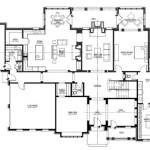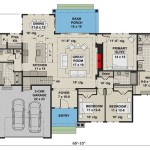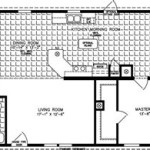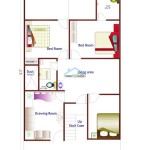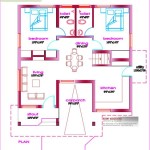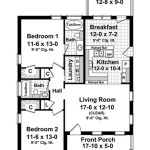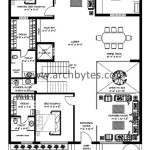Low Cost Modern Home Plans: Achieving Affordability Without Compromising Style
The dream of homeownership remains a cornerstone of societal aspiration, but the escalating costs of construction and materials often present a significant barrier. Low-cost modern home plans offer a viable solution, allowing individuals and families to realize this dream without incurring exorbitant debt. These plans prioritize efficiency, functionality, and contemporary aesthetics, demonstrating that affordability and stylish design are not mutually exclusive.
The concept of low-cost modern home plans revolves around strategic design choices that minimize material waste, simplify construction processes, and optimize space utilization. This approach requires a careful consideration of various factors, from selecting appropriate construction methods to incorporating energy-efficient features. By making informed decisions at each stage of the planning and building process, it is possible to create a modern home that is both budget-friendly and aesthetically pleasing.
Effective low-cost modern designs often leverage pre-fabricated components, modular construction techniques, and readily available materials. These methods reduce on-site labor costs and construction timeframes, contributing significantly to overall cost savings. Furthermore, smart space planning and the incorporation of multi-functional areas can minimize the need for larger square footage, further reducing construction expenses. The focus is on creating a comfortable and stylish living environment within a smaller, more manageable footprint.
Key Considerations for Low Cost Modern Home Design
Developing a low-cost modern home plan requires a thorough understanding of several key considerations. From site selection to material choices, each decision can impact the final cost and overall efficiency of the project. Prioritizing these considerations ensures the creation of a home that aligns with both budgetary constraints and modern design principles.
Site Selection: The location of the home plays a crucial role in determining construction costs. Sites with challenging topography may require extensive excavation and foundation work, significantly increasing expenses. Selecting a relatively flat and accessible site can minimize these costs. Furthermore, proximity to utilities and existing infrastructure can reduce the need for costly connections and extensions. A thorough site analysis, including soil testing and assessment of local building codes, is essential before finalizing the purchase of land. Consideration should also be given to local climate conditions, as this will influence the design's energy efficiency and material selections.
Foundation Options: The type of foundation chosen has a substantial impact on the overall cost of the project. Slab-on-grade foundations, while relatively simple and inexpensive, may not be suitable for all soil types or climates. Crawl space foundations offer a balance between cost and accessibility for plumbing and electrical systems. Basements, while providing additional living space, are typically the most expensive option and should only be considered if truly necessary and cost-effective in the specific location. The optimal foundation type will depend on the site's soil conditions, local building codes, and the overall design of the home.
Material Selection: Choosing affordable and durable materials is paramount to keeping costs down. Concrete block, wood frame construction, and engineered wood products are often more economical than steel or masonry. Siding options such as vinyl, fiber cement, and engineered wood offer a balance of affordability, durability, and aesthetic appeal. Interior finishes should also be selected with cost in mind. Laminate flooring, ceramic tile, and cost-effective paint colors can provide a modern look without breaking the bank. Sourcing materials locally can often reduce transportation costs and support local businesses. Furthermore, consider the long-term maintenance costs of each material when making selections, as seemingly inexpensive options may require more frequent repairs or replacements in the future.
Essential Elements of Affordable Modern Design
Specific design elements frequently contribute to the affordability and appeal of modern homes. Focusing on these elements can help streamline the planning process and ensure that the final product embodies both cost-effectiveness and contemporary style.
Open Floor Plans: Open floor plans are a hallmark of modern design and can contribute to cost savings by reducing the need for interior walls. This allows for a more efficient use of space and can make a smaller home feel larger and more airy. Open floor plans also promote natural light and ventilation, which can reduce energy consumption. Careful consideration should be given to furniture placement and zoning within the open space to create distinct living areas without sacrificing the feeling of spaciousness. The strategic use of lighting, rugs, and other design elements can help define different areas within the open plan.
Simple Rooflines: Complex rooflines add to construction costs and increase the potential for leaks. Simple gable or shed roofs are more affordable to build and maintain. A well-designed roof can also contribute to the home's energy efficiency by providing shade in the summer and allowing for solar panel installation. The pitch of the roof should be carefully considered to balance aesthetic appeal with practicality and cost. A steeper pitch may provide more attic space, but it will also increase material costs and labor time.
Efficient Windows and Doors: Windows and doors are a significant source of heat loss or gain. Investing in energy-efficient windows and doors can significantly reduce heating and cooling costs over the lifetime of the home. Double-paned or triple-paned windows with low-E coatings are recommended for optimal energy performance. Consider the orientation of the home when selecting window sizes and placement. South-facing windows can provide passive solar heating in the winter, while strategically placed awnings or overhangs can shade windows from the summer sun. Selecting durable and weather-resistant door materials is essential for longevity and energy efficiency.
Strategies for Minimizing Construction Costs
Beyond design choices, various strategies can be implemented to further minimize construction costs. These strategies focus on streamlining the building process, leveraging economies of scale, and making informed financial decisions throughout the project.
Phased Construction: If budgetary constraints are a major concern, consider a phased construction approach. This involves completing the essential structural elements and basic finishes first, then adding additional features or upgrades over time as funds become available. This allows homeowners to move into a functional home sooner and spread out the costs over a longer period. Careful planning is essential to ensure that the initial phase includes all necessary infrastructure, such as plumbing, electrical, and HVAC systems. Future phases should be planned in advance to minimize disruption and ensure compatibility with the existing structure.
DIY Where Possible: If you have the skills and time, consider taking on some of the construction tasks yourself. Painting, landscaping, and finishing work are all potential areas for DIY savings. However, it is important to be realistic about your abilities and to only tackle projects that you are confident in completing safely and correctly. Obtain necessary permits and inspections for any work you undertake, and always prioritize safety. Even small DIY projects can contribute to significant cost savings over the course of the construction project.
Value Engineering: Value engineering is a systematic process of analyzing different design options and construction methods to identify opportunities for cost savings without sacrificing quality or functionality. This involves working closely with the architect, contractor, and other professionals to explore alternative materials, construction techniques, and design elements that can reduce costs. Value engineering should be conducted early in the planning process to maximize its impact. This process requires a willingness to consider alternative approaches and to challenge conventional building methods. The goal is to achieve the same or better results at a lower cost.
By carefully considering these factors and implementing these strategies, individuals can create a low-cost modern home that reflects their personal style and meets their functional needs without exceeding their budget. The key is to prioritize careful planning, informed decision-making, and a willingness to embrace innovative design solutions.

Building On The Affordable House Plans Of 2024 Houseplans Blog Com

Small Modern Home Plans The House Designers

10 Modern House Plan You Can Build On A Budget

House Plan Ch265

Modern Style House Plans

Simple Low Budget Contemporary House Plans And Modern

Modern Style House Plans

Est House Plans To Build Simple With Style Blog Eplans Com
Affordable House Plans Our Est To Build Blog Homeplans Com

Low Budget Modern 3 Bedroom House Design


